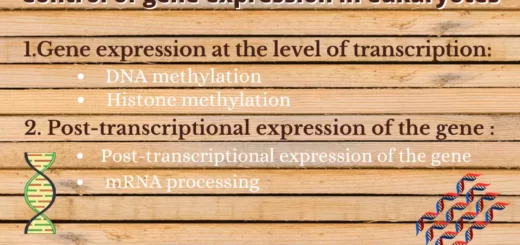Euchromatin and Heterochromatin
Chromatin is the complex of DNA and proteins (mainly histones and non-histones) found in the nucleus of eukaryotic cells. It exists in varying degrees of condensation throughout the cell cycle, influencing gene expression, replication, and repair.
The concept of euchromatin and heterochromatin was first introduced by Heitz in 1928, based on the differential staining and condensation patterns observed under a light microscope.
2. Definition
| Type | Definition |
| Euchromatin | The lightly stained, loosely packed region of chromatin that remains less condensed during interphase and is transcriptionally active. |
| Heterochromatin | The deeply stained, tightly packed region of chromatin that remains condensed during interphase and is transcriptionally inactive. |
3. Structural Differences
| Feature | Euchromatin | Heterochromatin |
| Staining | Lightly stained with basic dyes | Darkly stained |
| Chromatin density | Loosely packed (less condensed) | Densely packed (highly condensed) |
| Transcriptional activity | Transcriptionally active | Transcriptionally inactive |
| DNA content | Rich in genes and unique sequences | Composed mostly of repetitive DNA |
| Replication timing | Early S-phase | Late S-phase |
| Histone modifications | Acetylation of histones → open chromatin | Methylation of histones → compact chromatin |
| Chromosome region | Found in arms of chromosomes (interior nucleus) | Located at centromeres, telomeres, and periphery of the nucleus |
| Reactivation potential | Can become condensed under stress | Usually remains permanently condensed (except facultative form) |
4. Molecular Organization
4.1 Euchromatin
- DNA is loosely coiled around nucleosomes (10–30 nm fibre).
- Associated with active histone modifications such as:
- H3K4me3 (Histone H3 lysine 4 trimethylation)
- H3K9ac (Histone H3 lysine 9 acetylation)
- Open chromatin allows transcription factors, RNA polymerase, and regulatory proteins to access DNA.
- Contains unique sequences encoding structural and functional genes.
4.2 Heterochromatin
- DNA is tightly coiled (higher-order 30 nm fibre and beyond).
- Contains highly repetitive sequences (e.g., satellite DNA).
- Shows histone methylation marks like:
- H3K9me3 (Histone H3 lysine 9 trimethylation)
- H4K20me3 (Histone H4 lysine 20 trimethylation)
- Forms part of the nuclear lamina (near nuclear envelope) and is often associated with gene silencing.
5. Types of Heterochromatin
Heterochromatin is classified into two major types based on its behaviour during development and transcriptional potential.
A. Constitutive Heterochromatin
- Permanently condensed and transcriptionally inactive.
- Found in centromeres, telomeres, and pericentromeric regions.
- Composed mainly of tandemly repetitive DNA (satellite DNA).
- Functionally important for chromosome pairing, segregation, and structural stability.
- Rich in AT base pairs.
Examples:
- Centromeric heterochromatin in humans.
- Y chromosome in Drosophila.
B. Facultative Heterochromatin
- Conditionally condensed, depending on the developmental stage or cell type.
- Can switch between heterochromatin (inactive) and euchromatin (active) states.
- Contains genes that are temporarily silenced during development or differentiation.
- Rich in GC base pairs.
Examples:
- Barr body (inactivated X chromosome in female mammals).
- Hox gene clusters during embryonic development.
6. Formation and Maintenance
Epigenetic Modifications:
The state of chromatin (active or inactive) is maintained by epigenetic markers, such as:
| Modification | Effect on Chromatin |
| Histone acetylation (HAT enzymes) | Opens chromatin (Euchromatin) |
| Histone deacetylation (HDAC enzymes) | Condenses chromatin (Heterochromatin) |
| DNA methylation (CpG islands) | Gene silencing (Heterochromatin) |
| Histone methylation (H3K9me3, H4K20me3) | Promotes heterochromatin formation |
| ATP-dependent chromatin remodelling | Allows chromatin transition between states |
Key Proteins:
- HP1 (Heterochromatin Protein 1): Binds to methylated H3K9 and stabilizes heterochromatin.
- Polycomb group proteins (PcG): Maintain facultative heterochromatin during development.
- Chromatin remodelers (SWI/SNF, ISWI): Modulate chromatin accessibility.
7. Functional Significance
7.1 Euchromatin
- Houses most of the active genes responsible for cell function.
- Region of transcription, replication, and recombination.
- Allows rapid gene activation when needed.
- Essential for cell differentiation and metabolic regulation.
7.2 Heterochromatin
- Provides structural integrity to chromosomes.
- Ensures proper segregation during cell division.
- Suppresses transposable elements and repetitive sequences.
- Regulates gene expression by position effect (gene silencing when near heterochromatin).
- In telomeres, protects chromosome ends from degradation and fusion.
8. Dynamic Nature of Chromatin
Chromatin is not static — regions of euchromatin can become heterochromatic and vice versa in response to:
- Developmental cues,
- Cellular stress,
- DNA damage, or
- Environmental factors.
This chromatin plasticity forms the basis of epigenetic regulation, allowing cells to maintain identity while responding flexibly to environmental changes.
9. Euchromatin and Heterochromatin in the Cell Cycle
| Phase | Euchromatin | Heterochromatin |
| Interphase | Loosely packed, transcriptionally active | Condensed, inactive |
| Prophase | Begins to condense | Already condensed |
| Metaphase | Highly condensed | Remains condensed |
| Anaphase/Telophase | Segregates and decondenses | Stays condensed until cytokinesis |
10. Comparison Table
| Characteristic | Euchromatin | Heterochromatin |
| Staining | Light | Dark |
| DNA Type | Unique, gene-rich | Repetitive, gene-poor |
| Transcription | Active | Silent |
| Histone Modification | Acetylation | Methylation |
| Replication | Early | Late |
| Nucleosome Spacing | Widely spaced | Densely packed |
| Chromosome Location | Internal | Periphery (centromere, telomere) |
| Example | Active gene regions | Barr body, centromeric regions |
11. Functional Correlation with Genome Activity
Modern genomic mapping using ChIP-seq and Hi-C techniques shows that:
- Euchromatin corresponds to A-compartments (gene-rich, open regions).
- Heterochromatin corresponds to B-compartments (gene-poor, compact domains).
This spatial organization within the nucleus contributes to gene expression control and nuclear architecture.
Euchromatin and heterochromatin represent two functional states of the same genetic material, dynamically interconvertible and essential for maintaining genomic balance.
- Euchromatin ensures gene expression and adaptability,
- Heterochromatin guarantees stability, structural integrity, and silencing of unwanted genes.
Their interplay forms the foundation of epigenetic regulation, allowing complex organisms to orchestrate developmental and physiological processes with remarkable precision.
Join SACHIN’S BIOLOGY on Instagram or Facebook to receive timely updates and important notes about exams directly on your mobile device. Connect with Mr. Sachin Chavan, the founder of Sachin’s Biology and author of biologywala.com, who holds an M.Sc., NET JRF (AIR 21), and GATE qualifications. With SACHIN’S BIOLOGY, you can have a direct conversation with a knowledgeable and experienced professional in the field of biology. Don’t miss out on this opportunity to enhance your exam preparation!


